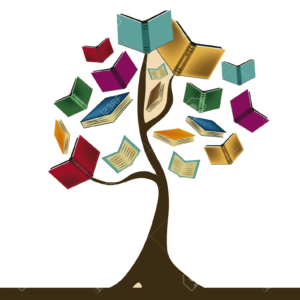 A Native American & Native Hawaiian library collection hosted by CPIR
A Native American & Native Hawaiian library collection hosted by CPIR
Developed by NAPTAC | Native American Parent
Technical Assistance Center
New resources being developed by LDAH | Leadership in Disabilities and Achievement of Hawaii
September 2024
The training and briefs that NAPTAC created for Parent Centers included specific worksheets, group activities, and resource lists, all of which are designed to strengthen Parent Center outreach to and interactions with Native parents of children and youth with special needs. Tier 4 brings these materials together in one place and includes contact lists and national organizations that represent Native Americans in the United States–American Indians, Alaska Natives, and Native Hawaiians. Tier 4 provides resources in 3 groupings:
- Contact Lists and National Organizations (See section below) | (State-specific contact lists for Indian Education coordinators, American Indian and Alaska Native Vocational Rehabilitation Centers, Indian Education schools and institutions, and federally recognized tribes and villages)
- Worksheets and Training Activities (Indian Bingo activity, Right or Privilege activity, Outreach worksheets 1 and 2)
- Additional Resources and Recommended Reads (research reports and informative analyses from other organizations)
Because the Native American collection will continue to evolve over time as CPIR updates existing products and shares new information relevant to Parent Centers working with Native communities, we’ll be adding items of note as they become available.
 Contact Lists and National Organizations: Find Your State’s Indian Education Contact!
Contact Lists and National Organizations: Find Your State’s Indian Education Contact!
(Also in Tier 2) | This list of State Indian State Education Contacts was developed for Parent Centers and other service providers to use in identifying and connecting with the individuals who serve as their state contact for American Indian and Alaska Native education. These individuals can be very helpful to Parent Centers and others in establishing and building relationships within Native communities in the state, and in learning about ongoing parent activities and initiatives that promote the well-being and achievement of Native students.
Updated for 2019, the list of contacts is available in Word, PDF, and here online at CPIR, at:
https://www.parentcenterhub.org/state-indian-education-contacts/
___________________
List of American Indian/Alaska Native Vocational Rehabilitation Centers
(New in September 2020) | This contact list will help you identify the vocational rehabilitation (VR) service programs for American Indians and Alaska Natives with disabilities in your state. With funding support of the Vocational Rehabilitation Services Projects for American Indians with Disabilities, tribal governments can develop or increase their capacity to provide a program of VR services, in a culturally relevant manner, to American Indians with disabilities residing on or near federal or state reservations. VR services are intended to help these individuals prepare for and engage in gainful employment. Program services are provided under an individualized plan for employment and may include native healing services.
CPIR is pleased to add this new resource to the Native American Resource Collection. Scroll through the list here online, where you can download it as an 8-page document in Word and in PDF:
https://www.parentcenterhub.org/aian-voc-rehab-center-contacts/
___________________
List of Bureau of Indian Education Schools/Institutions, by State
There are currently 55 schools operated by the Bureau of Indian Education (BIE) and 132 tribally controlled schools. All 187 are funded by the federal BIE. BIE’s mission is to provide quality education opportunities from early childhood through life in keeping with each tribe’s needs for cultural and economic well-being, while recognizing the wide diversity of Indian tribes as distinct cultural and governmental entities. BIE schools are intended to operate with consideration of the whole person by considering the spiritual, mental, physical, and cultural aspects of the individual within his or her family and tribal context.
The list of BIE-operated and tribally controlled schools can be found online at:
https://www.bie.edu/schools/directory
___________________
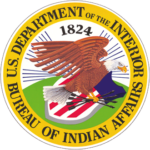
Bureau of Indian Affairs’ List of Tribes by State
The Bureau of Indian Affairs (BIA) first developed the Tribal Leaders Directory as an internal reference document for its employees. It quickly became one of BIA most requested documents, and is now used by federal, state and local governments, news media, businesses, researchers, and the general public as a resource to help them connect with Indian Country. Find the list of tribes at:
https://www.bia.gov/bia/ois/tribal-leaders-directory/
Back to top
___________________________________________
Worksheets and Training Activities
Here, for your use, we’ve assembled many of the worksheets and training activities developed by NAPTAC as part of providing training to two cohorts of Parent Center staff. Some of these resources also appear in other tiers in this collection, but we repeat them here for your convenience. As part of expanding the Native American Resource Collection, CPIR looks forward to adding more worksheets and updating training activities in the coming months.
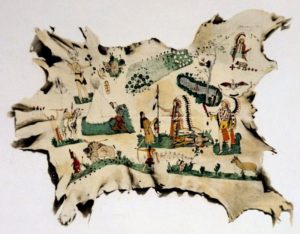 Bingo Activity
Bingo Activity
(Also in Tier 1) | Have you ever played Bingo? Most of us have at some point in our lives. The Indian Bingo Activity uses the typical Bingo game set-up to engage a group of people (e.g., staff at your Parent Center) in learning more about Native American history and culture. It was demonstrated as part of NAPTAC’s webinar Historical Perspectives for Working with Native American Parents. and includes such questions as “Who knows which tribe(s) is/are closest to your Parent Center?”
Updated in 2024! CPIR is pleased to update the Bingo Activity, so that it now also includes questions related to Native Hawaiian culture and history. Moreover, the game and all its components are available in Spanish! The 2020 materials are available in Word and PDF and include the following:
English version:
2020 Participant Bingo Card in Word | 2020 Bingo Card in PDF
2020 Bingo Answers in Word | The 2020 Answers in PDF
Instructions for Playing the 2020 Game (Word) | Instructions for Playing the 2020 Game (PDF)
Download all the components in one Word file | Download all the components in one PDF file
Spanish version:
2020 Tarjeta para jugar al bingo nativo americano (Word) | 2020 Tarjecta para jugar al bingo nativo americano (PDF)
Hoja de respuestas para la actividad (Word) | Hoja de respuestas para la actividad (PDF)
2020 Instrucciones para jugar (Word) | Instrucciones para jugar (PDF)
Descargar todos los componentes en Word | Descargar todos los componentes en PDF
___________________
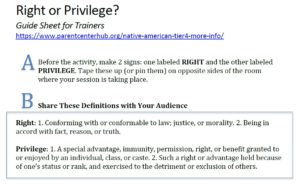 Right or Privilege Activity
Right or Privilege Activity
This intriguing activity was included in the webinar on Tribal Sovereignty that’s available in Tier 2. It’s one that Parent Centers can use in staff development as part of internal capacity building and as part of outreach planning. Its intent is to have participants explore their own understanding of what is a right and what is a privilege. Below, you’ll find the 1-page Trainer’s Guide to the activity and the two slides from the webinar that were used to describe the activity. The slides can be dropped into a PowerPoint presentation of your own; they include speaker notes.
2020 Trainer’s Guide to Right or Privilege Activity in Word | Trainer’s Guide in PDF
Right or Privilege Slides in PowerPoint | Right or Privilege Slides in PDF
___________________
Outreach Worksheets 1 and 2
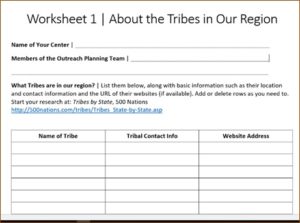 Would your Parent Center appreciate having worksheets that guide staff in gaining knowledge of the specific tribal communities in their area? These two worksheets are designed to help you do just that. They were provided as part of the webinar on Tribal Sovereignty and appear in Tier 2 materials—and, now, here. Worksheet 1 will help you identify tribes in your Parent Center’s region. Worksheet 2 will help you develop your Center’s own tribal directory, including such information as name of the tribe, the leader’s name and official title, contact information, the tribe’s website (if available), and much more. While you may decide that not all information types listed have to be gathered, tribal newspapers and TV or radio stations are ideal places to announce PTI events or to learn of local community events where you can outreach to hundreds of Native parents. We urge you to use this worksheet to organize and keep track of the most vital information about tribes in your area.
Would your Parent Center appreciate having worksheets that guide staff in gaining knowledge of the specific tribal communities in their area? These two worksheets are designed to help you do just that. They were provided as part of the webinar on Tribal Sovereignty and appear in Tier 2 materials—and, now, here. Worksheet 1 will help you identify tribes in your Parent Center’s region. Worksheet 2 will help you develop your Center’s own tribal directory, including such information as name of the tribe, the leader’s name and official title, contact information, the tribe’s website (if available), and much more. While you may decide that not all information types listed have to be gathered, tribal newspapers and TV or radio stations are ideal places to announce PTI events or to learn of local community events where you can outreach to hundreds of Native parents. We urge you to use this worksheet to organize and keep track of the most vital information about tribes in your area.
Worksheet 1 in Word (Identifying the Tribes in Our Region)| Worksheet 1 in PDF
Worksheet 2 in Word (Developing Your Own Tribal Directory) | Worksheet 2 in PDF
___________________
Additional Resources and Recommended Reads
 Infographic: Educating Native Students: Then and Now
Infographic: Educating Native Students: Then and Now
(Also in Tier 1 and Tier 3) | To better understand how the current Native education system was established, the National Indian Education Association (NIEA) produced the Native Nations and American Schools: The History of Natives in the American Education System in 2016. This infographic was created to summarize the findings described in the report and places the findings within a key historical truth that has greatly impacted how Native communities interact with schooling in the U.S. [2-page infographic, available in PDF only, 2024]
Educating Native Students: Then and Now| in PDF format
___________________
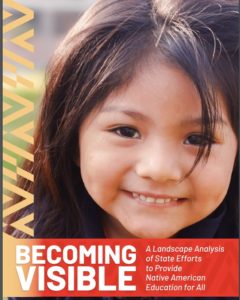 Becoming Visible: A Landscape Analysis of State Efforts to Provide Native American Education for All
Becoming Visible: A Landscape Analysis of State Efforts to Provide Native American Education for All
(Also in Tier 1) | This report is a valuable resource on the current state of Indian education, published in 2019 by the National Congress of American Indians (NCAI). The report is 52 pages long.
Background | In 2018, a disturbing reality was brought to the attention of NCAI: 87% of state history standards do not mention Native American history after 1900. The report details how NCAI responded by analyzing the extent to which states require and/or provide support for Native American K-12 curricula to all students. NCAI also reviewed state policies, laws, and practices with respect to the Native American K-12 curriculum they use. Their findings were alarming.
Why is this report part of the Native American Resource Collection? | We include NCAI’s report in Tier 4 (and Tier 1) to deepen Parent Centers’ awareness and understanding of why Native communities hold strong feelings toward education, which treats them as non-existent or describes them inaccurately and stereotypically. Parent Centers are sensitive to the fact that these false narratives, perpetuated in schools and curricula, damage the self-identity of Native children and youth, whether or not they have disabilities. The NCAI report makes three specific recommendations and offers a valuable toolkit, which provides action steps, worksheets, talking points, and other resources that allies, like Parent Centers, can use to support implementation of the recommendations.
Download NCAI’s Analysis and Findings |
https://archive.ncai.org/policy-research-center/research-data/prc-publications/NCAI-Becoming_Visible_Report-Digital_FINAL_10_2019.pdf
Back to top
___________________________________________
Which part of the NAPTAC Library would you like to visit now?
Return to the Native American Resource Collection’s landing page
Tier 1: Native Culture and Background
Tier 2: Outreach to Native Communities
Tier 3: Native Children and Youth
Tier 4: Additional Resources (You’re already here)

